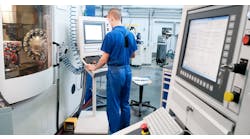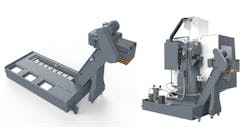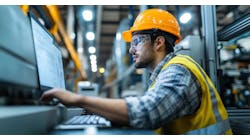For manufacturing professionals COVID-19 was a wake-up call about health and safety: How the processes have been taken for granted, and how underprepared everyone has been for a public health emergency. Manufacturing safety procedures should always be the top priority among operations managers, but COVID-19 has complicated an already complex and detail-oriented task. As manufacturers spool up their operations and begin recalling furloughed workers, how can the industrial economy reopen safely? Which “business-as-usual” tasks need to change?
How is safety in manufacturing changing in the aftermath of the coronavirus? Here’s a look at a few of the ways technologies, workflows and procedures are being modified.
1. Implementing new pre-shift procedures. According to the U.S. Equal Employment Opportunity Commission (EEOC), under normal circumstances employers cannot interview their workforce about personal health matters. Now, with COVID-19 a part of daily life for the foreseeable future, this precedent must change in some critical ways, in order to help reduce the spread of the virus.
First, in April 2020 the EEOC released a guidance document indicating that employers may take workers’ temperatures before their shifts and ask if they’ve experienced any coronavirus symptoms.
Second, many manufacturing plants and other industrial operations are rolling out standardized technology processes for screening workers for symptoms on their way into the facility.
These processes include automated machine vision kiosks, thermal imaging cameras and even drones for screening employees for signs of fever, coughing, or other behaviors that could spread the virus once they step onto the production floor.
2. Adapting facilities to social distancing. Scientists anticipate that social distancing will have to continue through 2022 if there’s no expedient path to a vaccine. This poses a critical challenge to manufacturing plants.
Manufacturing and distribution hubs can be big spaces, but they still find workers performing their duties in close proximity. Sometimes employees on a process line must transport workpieces between each another, and order pickers regularly bump shoulders in stowing areas.
Organizations must make what in some cases will be sweeping changes to uphold social distancing standards and "flatten the curve." Focus on these points:
• Reconsider time clocks: Punching in and out for shifts is a major traffic bottleneck in factories. Explore alternatives to physically clocking in and out, such as geofencing-enabled timesheet smartphone apps.
• Stagger shifts and arrivals: If possible, manufacturers should split up shifts and stagger them through the work week, to limit concurrent occupancy. Employee arrivals and start times should be staggered too, to avoid congestion and close contact.
• Reposition workstations: Manufacturers must adjust workstations and powered equipment across the plant floor so that employees can perform their functions and maneuver while keeping away from others.
• Use automation: Automated pallet trucks and other cobots are another way to get work done or transport materials without having employees work closely beside each another.
3. Expanding cleaning crews and hygiene procedures. Plant cleanliness and personal hygiene are shared challenges, but workplace leaders in manufacturing, construction, distribution, and other industrial settings can help set the right tone.
The United States Centers for Disease Control and Prevention regularly updates its cleaning and hygiene guidance documents as current events require. Manufacturers should adopt and add these procedures to their training. For instance, washing one’s hands after using shared spaces or blowing one’s nose should become a matter of muscle memory for employees.
Maintaining lawful compliance in the workplace for safety’s sake, not to mention supporting employee morale during difficult times, requires mindful attention to several other priorities, including:
• Regular cleanings of the facility
• Ready access to soap and cleaning products
• Ample supplies of single-use towels and tissues
• Hand sanitizer with at least 60% alcohol content
• Face masks and other appropriate PPE.
Now is an excellent time to post signage and provide regular reminders to cover one’s face when sneezing and coughing, as well as to refrain from using other people’s tools or belongings, unless absolutely necessary.
Automation can play a role in keeping facilities clean and safe as well. Even employers who previously had little interest in cleaning robots are getting on board.
COVID-19 helped to bring about a two-digit increase in robot sales for some industrial automation companies. Floors are not a well-observed coronavirus vector, but automating low-priority cleaning procedures keeps cleaning crews focused on high-traffic, high-touch surfaces and areas.
4. Tightening security and access control. It may not look like it every day, but the world has become safer, more secure, and less violent over the last several decades. In the last 100 years, improvements in corporate and regulatory culture brought a 95% drop in the likelihood of an employee dying at work. Modern employers are not without their security and safety challenges, though.
Before COVID-19, there was a rising fear of workplace violence and domestic terrorist incidents. Many manufacturers will emerge from this crisis with much tighter security and access-control procedures than they had before the outbreak. These improvements should be fruitful on several fronts, including the quest for tighter security and peace of mind amid the pandemic.
To start, many sites have significantly curtailed or even eliminated visitor access to help stop the spread of the virus. Others limit access to selected third-parties when they’re critical to keeping operations going.
Internet of Things (IoT) technologies can play a role as well, especially in plants forced to operate with limited personnel. Remote-access control gives manufacturers tools to monitor site access, award or revoke credentials remotely, and keep tighter control over the traffic throughout facilities.
The new era for safety in manufacturing — The outbreak of COVID-19 has been an inconvenience to some and devastating to many more. If treated as a learning experience, it’s possible to find value even in a tragic event like this one. With attention to these manufacturing safety priorities, the industry will find its footing again while improving efficiency, wellness, cleanliness, and safety.
Eventually, manufacturers should be better off than they were before the outbreak. For this to happen, leaders must use the coming weeks and months to improve communications with their workforce, and to learn how to make the best investment in safety and peace of mind, rather than just profitability.
Kayla Matthews writes about the IoT, IIoT, automation and smart technologies for publications like InformationWeek, Manufacturing.net, Robotiq others. Follow Kayla at her personal tech blog, Productivity Bytes.






